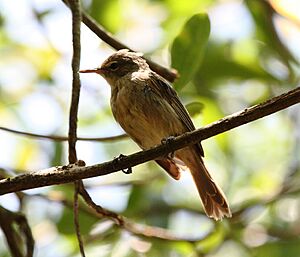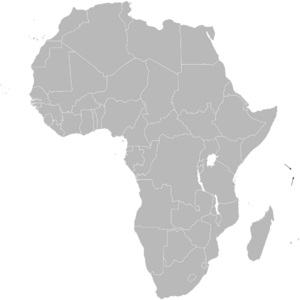Seychelles warbler facts for kids
Quick facts for kids Seychelles warbler |
|
|---|---|
 |
|
| Conservation status | |
| Scientific classification | |
| Genus: |
Acrocephalus (bird)
|
| Species: |
sechellensis
|
 |
|
| Synonyms | |
|
Bebrornis sechellensis |
|
The Seychelles warbler (Acrocephalus sechellensis) is a small songbird found on five islands in the Seychelles. These islands are located in the Indian Ocean. This bird is also known as the Seychelles brush warbler. It has greenish-brown feathers, long legs, and a thin bill. You can mostly find it in the forests on these islands.
The Seychelles warbler is special because it uses a system called cooperative breeding. This means that other birds, called "helpers," assist the parent birds in raising their young. These helpers are usually non-breeding females.
Not long ago, the Seychelles warbler was almost extinct. In 1968, only 26 birds were left on Cousin Island. Thanks to a lot of hard work in conservation, there are now over 2,500 of these birds alive. They live on Denis, Frégate, Cousine, Aride Island, and Cousin Island.
Contents
What is a Seychelles Warbler?
The Seychelles warbler is a small, plain bird. It belongs to a group of birds called Acrocephalus warblers. It is about 13 to 14 centimeters (5 to 5.5 inches) long. Its wingspan is around 17 centimeters (6.7 inches).
Appearance of the Seychelles Warbler
This bird has long, grey-blue legs. Its bill is long and horn-colored. It also has reddish eyes. Both male and female adult birds look the same. Their backs, wings, sides, and heads are greenish-brown. Their bellies and chests are a dull white color. The throat is a brighter white. There is also a pale stripe above its eye. Young birds are darker and have more bluish eyes.
The Song of the Seychelles Warbler
The voice of the Seychelles warbler is described as "rich and melodious." It sounds a bit like a human whistle. Its song is simple, with short musical parts. It uses a low range of sounds. This makes its song different from other birds in its group, like the reed warbler. However, its song is similar to its close relatives in Africa.
Where the Seychelles Warbler Lives and What It Eats
The Seychelles warbler naturally lives in thick shrubland and tall forests. It especially likes forests with Pisonia grandis trees.
What the Seychelles Warbler Eats
This bird mainly eats insects. About 99.8% of its diet is insects. It gets most of its food by gleaning. This means it picks small insects from the undersides of leaves. Sometimes, it also catches insects while flying. It mostly looks for food on Pisonia, Ficus reflexa, and Morinda citrifolia plants.
Studies show that Seychelles warblers prefer Morinda plants for foraging. They spend more time looking for food there than in other trees. The same studies found that there are more insects under the leaves of Morinda. Planting Morinda on Cousin Island helped the warbler find more food. This was a very important part of helping the species recover.
Cooperative Breeding and Reproduction
Seychelles warblers show cooperative breeding. This is a special way of raising young. In this system, adult male and female helpers assist the parent birds. They help by feeding the young birds. These helpers might also help protect the territory. They can mob (attack) predators, build nests, and even incubate eggs (female helpers only).
Benefits of Having Helpers
Breeding pairs with helpers have more success. They produce more young birds that survive each year. This is compared to pairs that do not have helpers. Helpers only feed the young of their own parents or close relatives. They do not feed young birds that are not related to them. This shows that helping close family members is a good strategy for survival.
Why Some Birds Become Helpers
In areas with lots of insect prey, young birds are more likely to stay as helpers. They would rather help than move to areas with less food to become breeders. In areas with less food, having a helper is not good. This is because there is more competition for food.
Female birds are more likely to become helpers. This might explain why Seychelles warblers have a special sex ratio (number of males to females). In good areas with lots of food, females produce about 90% daughters. In areas with less food, they produce about 80% sons. Overall, more daughters are born than sons. When females move to better areas, they lay two eggs instead of one. Both of these eggs are more likely to be female. This suggests that Seychelles warblers might be able to control the sex of their offspring before the eggs are laid. However, how they do this is still a mystery.
Images for kids



